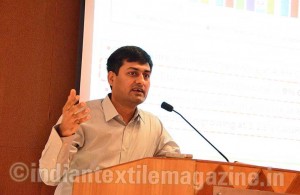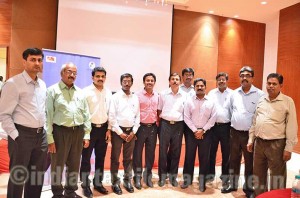Growing demand for VSF
Birla Cellulose, the fibre business of Grasim Industries, recently organised a knowledge sharing session on organisational improvements at Salem inviting all key customers in the region.

Mr. Ashwin J. Laddha, Senior Vice President, Sales and Marketing (India, SAARC and Far East), Pulp & Fibre Business, Grasim Industries Ltd., spoke on the emerging trends in VSF business.
The forum was also addressed by Dr. G. Thilagavathi, Professor & HoD, Department of Textile Technology, PSG Tech, and professionals from SITRA.
Grasim Industries’ strategic intent continues to be in strengthening its leadership position in VSF. Significant progress has been made in this regard. The capacity expansion from 334K TPA to 498K TPA is in its final stage. Of this, the brownfield expansion (36K TPA) at Harihar, Karnataka, has been completed. Its greenfield project (120K TPA) at Vilayat in Gujarat has already started trial runs in a few of its lines. Besides increasing volumes, the plant will augment its presence in speciality fibres such as modal and micro-modal.
Globally, total textile fibre consumption has been growing at a steady pace of four per cent from 2008 to 2012. The rate of growth, going forward, is expected to remain around this level. Against this, world demand for VSF has grown at 12 per cent CAGR (CY 09-CY 13), primarily driven by the VSF industry in China (CAGR of 15 per cent in last five years).
In the long term, with limitations for growth of cotton production due to competition with other cash crops, growing population, rising prosperity and growing consumer awareness about the benefits of cellulosic fibre, VSF is well positioned to achieve a larger share of the global fibre pie.
Mr. Ashwin spoke about the increase in consumption of VSF in traditional cotton spinning markets like the South. There is a steady increase in demand from markets like Erode, Salem and Pallipalayam for VSF. Also some of the big mills across India are now planning to convert 10-15 per cent of the spindles to run synthetic fiber. This could well be a game changer, he added.
Grasim Industries, with its enhanced capacities at the Harihar plant, increased its production by seven per cent compared to FY12-13. Capex plans amounting to Rs. 2,725 crores are under implementation, including the greenfield Vilayat project. The additional capacity from the ongoing greenfield expansion at Vilayat would lead to growth in volumes. The company continues to focus on specialty fibres as well. Further, Grasim focus is on improving its cost competitiveness and maintaining its leadership position in the market.
Technology upgradation
Grasim’s joint venture with Domsjo’s pulp R&D team is improving its fibre and process performance. The results are being applied across the pulp production sites to help optimize performance along the integrated value chain.

The Grasim Forestry Research Institute (GFRI) at Harihar has been strengthened and the Tissue Culture (TC) protocols have been modified to match different genotypes and species to improve efficiency of the micro propagation process to contribute to better planting stocks for local wood supplies.
The Birla Research Institute for Applied Sciences (for fibres) at Nagda is focused on accelerating improvements in new fibre production technologies. The Textile Research and Application Development Centre (TRADC) at Kharach has ushered in novel applications for fibres to quicken growth and improve the overall market position.
The R&D expansion project at Aditya Birla Science & Technology Company Ltd. (ABSTCL), an associate of Grasim Industries at Taloja, is in place. It is contributing to scaling sophisticated laboratory and semi-works capabilities for fibre research. Construction of the semi-commercial scale Fibre Research Centre at Kharach is complete and a project portfolio has been developed. This will contribute significantly to the fibre process and product R&D programmes in 2014 and beyond.
These investments, along with significant increases in R&D resources and the growing analytical and research support available through the corporate R&D organisation at Taloja are integral to the company’s growth. A core team of R&D professionals are actively engaged in various technology programmes and initiatives.
Importantly, external knowledge networks to complement internal capabilities are actively contributing to advanced technologies in the areas of cellulose pulp and novel new fibres.